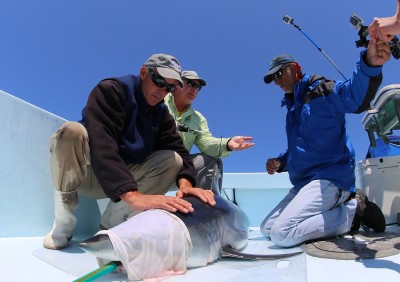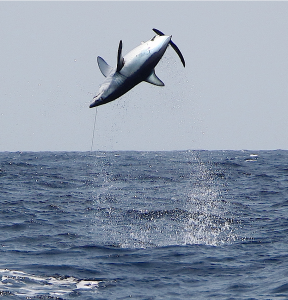NSU Newsroom
SharkBytes
Horizons
This version of NSU News has been archived as of February 28, 2019. To search through archived articles, visit nova.edu/search. To access the new version of NSU News, visit news.nova.edu.
This version of SharkBytes has been archived as of February 28, 2019. To search through archived articles, visit nova.edu/search. To access the new version of SharkBytes, visit sharkbytes.nova.edu.
NSU Shark Scientists in New National Geographic Kids’ Book

The Guy Harvey Research Institute (GHRI) team attaches a satellite tag to the fin of a shortfin mako shark.
National Geographic Kids Mission: Shark Rescue, a new children’s book exploring the survival challenges facing the fascinating, ecologically critical, and in many cases rapidly dwindling ocean predators, features the work of research scientists and faculty at NSU’s Halmos College of Natural Sciences and Oceanography.
Mahmood Shivji, Ph.D., professor at the college, director at the Guy Harvey Research Institute (GHRI) and Save Our Seas Shark Research Center US, and a biologist who has studied sharks for 19 years, is featured prominently, including an interview in which he explains why and how he is researching and helping conserve sharks.
“Sharks are amazing creatures who are also in dire need of saving because they have been overfished,” Shivji tells readers of the book written by Ruth A. Musgrave and published by the National Geographic Society in March 2016. “My aim in studying sharks is to satisfy my curiosity about how they work, but also to contribute to information and awareness that will help conserve them. The thing that constantly jumps out is how little we still understand about sharks.”
In the interview, Shivji said he is expanding the Guy Harvey Research Institute’s long-term shark tracking studies to decipher their movement patterns, including understanding “the where, when, and why of their amazing long distance migrations.”
In additional to their ecological studies, Shivji’s team also conducts genetics and genomics research on sharks. The Save Our Seas Foundation Shark Research Center at NSU is unraveling the genomes of sharks to understand– at the most fundamental level– “what makes a shark a shark.
“We hope our discoveries will raise the public’s awareness of how absolutely fascinating sharks are, and the importance of saving them,” Shivji said.

A shortfin mako shark leaps into the air while attached to a fishing line. The shark was tagged with a satellite tracking device and released.
Also mentioned in the book is Derek Burkholder, Ph.D., a research associate at the Guy Harvey Research Institute and Save Our Seas Shark Research Center, who spent a day helping teenage marine science students catch, tag, measure, and collect tissue, DNA, and other samples from sharks before releasing each animal unharmed into the water.
Mission: Shark Rescue also tells the story of “1-NSU,” a juvenile male shortfin mako shark who was tracked via a satellite tag by the GHRI scientists for 14 months beginning in May 2013.
Nicknamed after NSU, the five and a half foot shark (who can reach 10 feet long by adulthood) “revealed a new dimension of a juvenile mako shark’s world,” according to Musgrave.
NSU scientists tracked 1-NSU as he swam north from Maryland to Nova Scotia, Canada, and then south to Venezuela—traveling at least 12,000 miles before his tag stopped sending transmissions in July 2014.
To follow the tracks of GHRI tagged sharks in near real time, go to www.ghritracking.org.